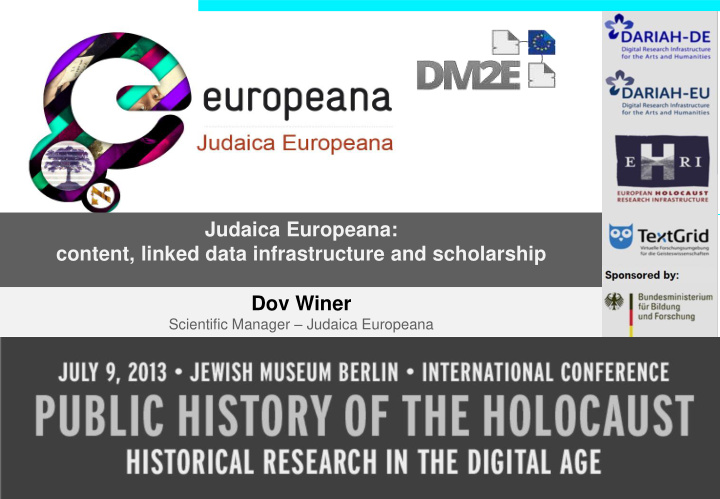



Judaica Europeana: content, linked data infrastructure and scholarship Dov Winer Scientific Manager – Judaica Europeana
Outline Aggregation of CURATED Jewish related content Integrated in the European Culture digital documentation: EUROPEANA Linked Data Infrastructure Service: Europeana Data Model adopted also by the Digital Public Library of America Challenge : to make good the Linked Data potential for CONTEXT enrichment: Who, What, When, Where . Provision of Digital Scholarship tools and approaches for research and higher learning Support for digital storytelling
* * YIVO: The Power of Persuasion, Jewish Posters from Prewar Poland 1900-1939 http://www.yivoinstitute.org/exhibits/posterfr.htm
Jews and the City Prof. Steven Zipperstein points to the anti-urban bias of most of the Jewish historiography and how this began to change at the end of the 20th century. S. Zipperstein (1987), Jewish Historiography and the Modern City . Jewish History V.2, pp 77-88 “ Modernization is about everyone becoming urban, mobile, literate, articulate, intellectually intricate, physically fastidious, and occupationally flexible. It is about learning how to cultivate people and symbols, not fields and herds. It is about pursuing wealth for the sake of learning, learning for the sake of wealth, and both wealth and learning for their own sake. It is about transforming peasants and princes into merchants and priests, replacing inherited privilege with acquired prestige, and dismantling social estates for the benefit of individuals, nuclear families, and book-reading tribes (nations). Modernization, in other words, is about everyone becoming Jewish .” Yuri Slezkine (2004). The Jewish Century . Princeton: Princeton University Press,. For the first chapter: http://press.princeton.edu/chapters/s7819.html
The Judaica Europeana project in a nutshell Co-funded by the eContentPlus program of the European Commission: initial budget framework of 3 Million Euro First stage 2010-2012: aggregation of content focused on theme of Jews in European Cities Second stage 2012-16: MOU : Memorandum of Understanding between partners Digital Manuscripts to Europeana DM2E: a 3-year Digital Humanities project from 2012 Athena Plus : 3-year project with a Digital Storytelling component from 2013 The program Digitisation and aggregation of Jewish content for EUROPEANA: 5 million CHO Adoption of standards to synchronise the metadata with the requirements of Europeana. K nowledge management tools: vocabularies, thesauri and ontologies for the indexing, retrieval and re-use of the aggregated content. Contextual metadata enrichment. Use of digitised content in academic research ; university-based teaching; schools; museums and virtual exhibitions ; conferences; cultural tourism; the arts and multimedia.
~3,700,000 digital objects DM2E – another 1,500,000 and many additional expressions of interest
Judaica Europeana Partners
Europeana
”
Europeana architecture Slide taken from the presentation by Cesare Concordia , ISTI/CNR at the LIDA 2009 Workshop
Linked Data The Web as an universal database Semantic Web, RDF, Named Graphs for controlling provenance
”
Linked Open Data Datasets on the Web: 10/2011 Over 31.7 billion RDF triples Linking Open Data http://www.linkeddata.org cloud diagram, by http://esw.w3.org/DataSetRDFDump Richard Cyganiak and Anja Jentzsch. http://esw.w3.org/TaskForces/CommunityProjects/Linki http://lod-cloud.net/ ngOpenData/DataSets/Statistics
The essence of RDF: the “triple” property subject value Source: “The thirty minute guide to RDF and Linked Data”, by Ian Davis and Tom Heath
RDF 2.0 Named Graphs: Provenance information From the ‘name that graph’ presentation by Fabien Gandon and Olivier Corby
Who? What? When? Where? Controlled vocabularies: hubs of Jewish Knowledge in the Structured Web
http://www.judaica-europeana.eu/Search_Europeana_Collections_with_Judaic_categories.html
http://www.judaica-europeana.eu/Search_Europeana_Collections_in_Hebrew.html
Who?
When ?
Where? Jewish gazetteers
Jewish encyclopedias: CONTEXT The goals of the project Linking and Populating the Digital Humanities are to create and maintain data integration tools tailored to digital humanities collections in order to build a machine- readable web of facts about covered domains.
Jewish encyclopedias: CONTEXT Encyclopedia Judaica http://www.jewishencyclopedia.com/ Encyclopedia of Russian Jewry http://www.rujen.ru/
Tasks for a common agenda on Jewish vocabularies • Who? Names • Disseminate the use of VIAF • Seek to include periodical publications in VIAF • RAMBI • Long term common effort to achieve comprehensiveness • Where? Places • JewishGen and Yad Vashem gazetteers as linked data ? • Use Europeana guidelines to map places coordinates • Registry of Jewish gazetteers / RDF/ community based Jewish gazetteer service similar to GeoNames, Freebase, LinkedGeoData etc • When? Periods • Survey available vocabularies and seek to express them as Linked Data • Institutional tools for in-depth probe on current periodisation practices h ttp://www.judaica-europeana.eu/docs/jewish_vocabularies_LOD.pdf
Digital Humanities: Scholarship and Teaching
Slide from the presentation by PhD Dr Stefan Litt at the 8 th EVA/Minerva Jerusalem Conference, November 2011 http://www.minervaisrael.org.il/2011/20111116_EvaMinerva_Haskala_StefanLitt.pdf
Judaica Europeana Storytelling in Athena Plus
www.judaica-europeana.eu Thank you for your attention! Dov Winer Judaica Europeana Scientific Manager European Association for Jewish Culture dov.winer@gmail.com
Recommend
More recommend